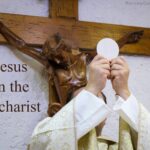
Eucharistic adoration is prayer, quiet reflection, and worship in the presence of the Blessed Sacrament. It is a time to spend with Jesus, literally and truly present in the Eucharist.
Jesus gave Himself to us in the form of bread so that he could remain close to us in our time.
Adoration of the consecrated host outside of Mass can be performed while Jesus is present in the tabernacle or while He is exposed in a monstrance during a holy hour.
Some churches have perpetual adoration where the Eucharist is made available for longer, uninterrupted periods of time.
The what, why, and how of adoration:
And he took bread, and when he had given thanks he broke it and gave it to them, saying, “This is my body which is given for you. Do this in remembrance of me.”
Luke 22: 19
In the presence of Jesus:
It is highly fitting that Christ should have wanted to remain present to his Church in this unique way. Since Christ was about to take his departure from his own in his visible form, He wanted to give us his sacramental presence; since He was about to offer Himself on the cross to save us, He wanted us to have the memorial of the love with which He loved us “to the end,” even to the giving of his life. In his Eucharistic presence He remains mysteriously in our midst as the one who loved us and gave Himself up for us, and He remains under signs that express and communicate this love.
Catechism of the Catholic Church 1380
It looks like bread, but we are worshiping Jesus:
During adoration, the Eucharist is displayed in a monstrance or ostensorium:
“We don’t feel what’s happening but we do change.”:
Indeed, since the Eucharistic Mystery was instituted out of love, and makes Christ sacramentally present, it is worthy of thanksgiving and worship. And this worship must be prominent in all our encounters with the Blessed Sacrament, both when we visit our churches and when the sacred species are taken to the sick and administered to them. Adoration of Christ in this sacrament of love must also find expression in various forms of Eucharistic devotion: personal prayer before the Blessed Sacrament, Hours of Adoration, periods of exposition-short, prolonged and annual (Forty Hours)-Eucharistic benediction, Eucharistic processions, Eucharistic congresses.
Pope John Paul II, Dominicae Cenae, February 24, 1980
Worship Jesus regardless of what form He appears:
Eucharistic adoration is not a step backward:
The Truth, Goodness, and Beauty of the Catholic Church
Another rich, cultural Catholic heritage:
Share this page with friends and family to start a conversation about your faith.
Don’t miss a post. Learn more about the Catholic Church and strengthen your Catholic faith.
Find more Fiercely Catholic video issues here.
Subscribe here.


